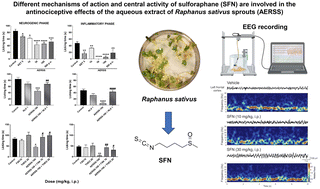Antinociceptive effects of Raphanus sativus sprouts involve the opioid and 5-HT1A serotonin receptors, cAMP/cGMP pathways, and the central activity of sulforaphane
Abstract
Raphanus sativus L. cv. Sango, commonly known as red radish, is widely consumed around the world as a vegetable, but its benefit in pain relief is not sufficiently investigated. This study aimed to evaluate the antinociceptive effects of R. sativus and a possible mechanism of action. An aqueous extract of R. sativus sprouts (AERSS) was investigated by parenteral (10, 30, and 100 mg kg−1, i.p.) and enteral (500 mg kg−1, p.o.) administration in the neurogenic and inflammatory phases of the formalin test, where gastric damage was also evaluated as a possible adverse effect. Ketorolac (5 mg kg−1, i.p.) was used as the reference drug. Endogenous opioid and 5-HT1A serotonin receptors, as well as the cAMP/NO-cGMP pathways, were explored in the study of a possible mechanism of action by using their corresponding antagonists: naloxone, 1 mg kg−1, i.p., WAY100635, 1 mg kg−1, i.p., and enzymatic activators or inhibitors, respectively. Sulforaphane (SFN), a known bioactive metabolite, was analyzed using electroencephalography (EEG) to evidence its central involvement. A significant and dose-dependent antinociceptive activity was observed with the AERSS resembling the antinociceptive effect of the reference drug, with an equivalent significant response with a dose of 500 mg kg−1, p.o. without causing gastric damage. The participation of the endogenous opioid and 5-HT1A serotonin receptors at central and peripheral levels was also observed, with a differential participation of cAMP/NO-cGMP. SFN as one metabolite produced significant changes in the EEG analysis, reinforcing its effects on the CNS. Our preclinical evidence supports the benefits of consuming Raphanus sativus cv. Sango sprouts for pain relief.



 Please wait while we load your content...
Please wait while we load your content...